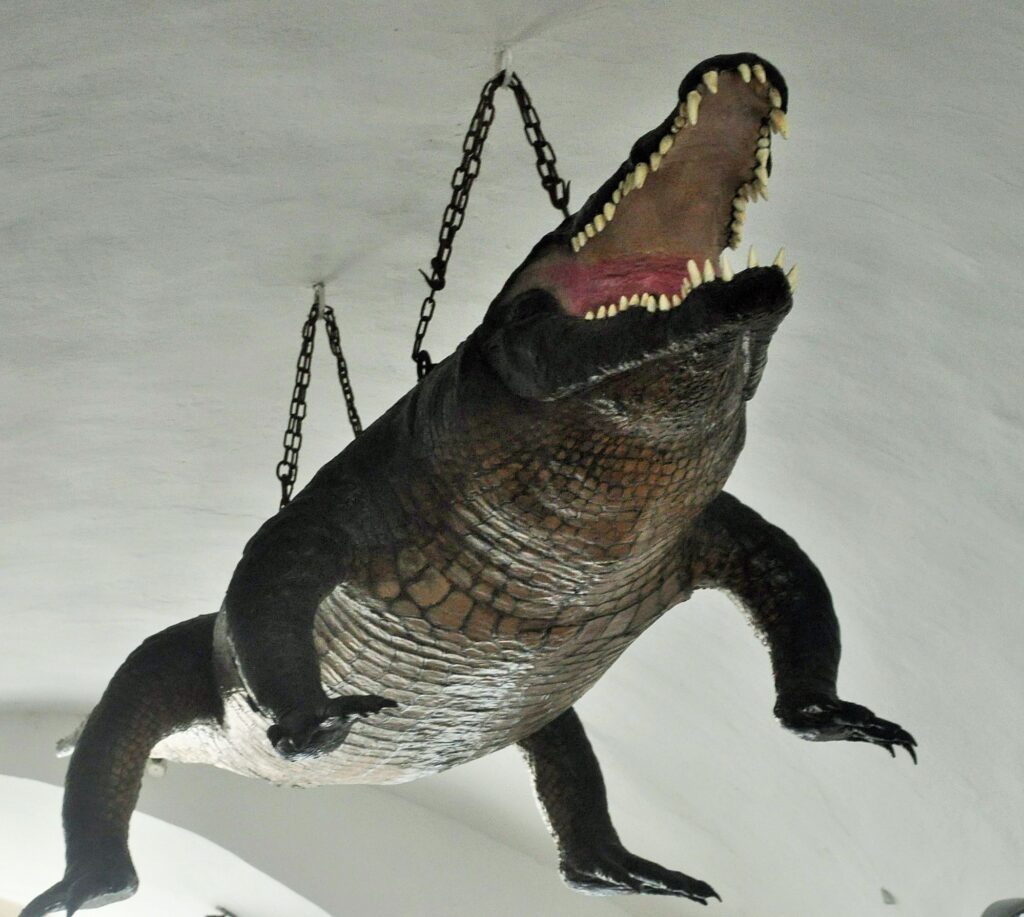Old Catholic churches often house treasure troves of religious art and relics. From frescoes to altarpieces to the alleged belongings of various saints, church collections can be both impressive and eccentric, especially in churches that date many centuries back. The Santuario Madonna delle Lacrime Immacolate, in English “The Sanctuary of Our Lady of Immaculate Tears,” is one such old church which is perhaps best known for a particularly strange piece of “art.”
More Macabre History: Elmer McCurdy: The Six Million Dollar Mummy
The Church Crocodile
Hanging from the rafters of the Santuario Madonna delle Lacrime Immacolate is a beast which resembles a dragon out of Revelations. With a leathery hide and toothy jaws, the church’s most unusual installation is the taxidermied body of a large crocodile. It is not known exactly how long this crocodile has belonged to the church, nor is it certain how the church came to own it. What we do know, however, is that the Santuario Madonna crocodile is one of the oldest existing pieces of taxidermy in the world. Dating as far back as 1514, the church’s records include documents involving discussions regarding the potential removal of the crocodile from the church. This means that this crocodile is at least 500 years old. (1)
It is thought that the crocodile taxidermy was missing for several years. According to church records, it was relocated in the attic of the church during the eighteenth century and was subsequently hung from the rafters where it remains to this day.
More Strange History: The Fox Sisters: How a Prank Created the Modern Ghost Story
A Reptilian Tradition
The Santuario Madonna crocodile seems like a one-off oddity, however it is not the only such beast to be found in a Catholic church. Within the walls of the Santuario Della Beata Vergine Maria Delle Grazie or “Sanctuary of Our Vergine Maria of Grace” hangs yet another crocodile taxidermy. In this case, the enormous reptile is said to have been an escapee from the private menagerie of the Duke of Mantua. This crocodile was allegedly caught and killed by a local fisherman sometime during the fifteenth or sixteenth centuries. From there, it was given to the church. (2)
While it is difficult to find an exact number, or even a useful approximation, taxidermied crocodiles seem to be an uncommon but not altogether unheard of feature of various old churches and similar buildings. Most examples are suspended from the ceiling via chains, however crocodile hides or complete taxidermies are also found adorning the walls of various buildings from this period.
But why have several historic churches chosen to display these crocodile taxidermies? There are a number of possible explanations. For one thing, a crocodile would not have been a common sight for many of the people in these regions at the time. The body of a crocodile was an exotic treasure which would allow people who would otherwise never see such an animal to experience something fearsome and unfamiliar from parts unknown. Furthermore, reptiles often hold a biblical connection with demonic forces. It is thought, then, that hanging these crocodiles might symbolize a conquest over the forces of evil or a ward against the satanic. (3)

More Mysterious History: Ancient Treasure from the Dead Sea Scrolls: What is the Copper Scroll?
Hanging Dragons
Churches are not, in fact, the only places where such strange relics can be found. In the town of Brno in Czechia, for example, a particularly massive crocodile hangs in the old town hall building. Ask the citizens of Brno to tell you the story, though, and you might not hear the word “crocodile” at all. According to local legend, this beast, known as the “Brno Dragon” once terrorized the town. The supposed “dragon” would steal livestock and kill indiscriminately. To end this menace, a local butcher fed the dragon a hunk of meat laced with lye. As a symbol of the dragon’s defeat, it was preserved and hanged in the town hall. Of course, it is plain to see that the dragon is, in fact, a massive crocodile. The origin of this taxidermy is unknown, however it is believed to have been gifted to Brno by a visiting dignitary. Some legends even suggest that a Turkish Sultan provided this fearsome beast’s preserved body. (4)
The Brno Dragon demonstrates just how exotic and awe-inspiring such pieces must have been for people who had never seen such large reptiles before. Ignoring its lack of wings and fiery breath, a large crocodile is just about the closest thing to a dragon upon this earth. For a church, this could symbolize man’s ability to conquer the serpent of Satan, sure, but it could also simply serve as a reminder of the breadth and the spectacle of creation.
More Obscure History: The Dog Who Became a Saint